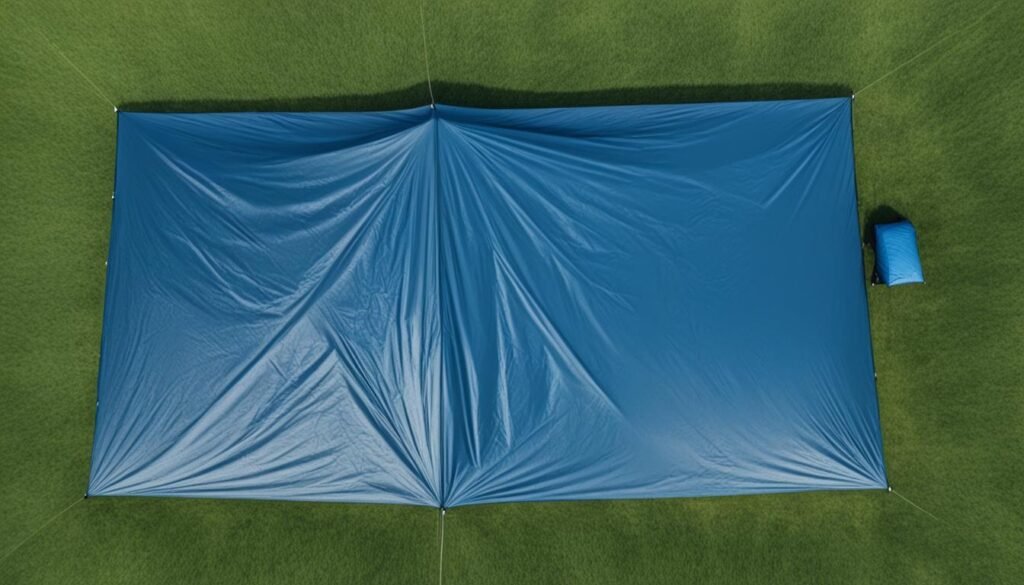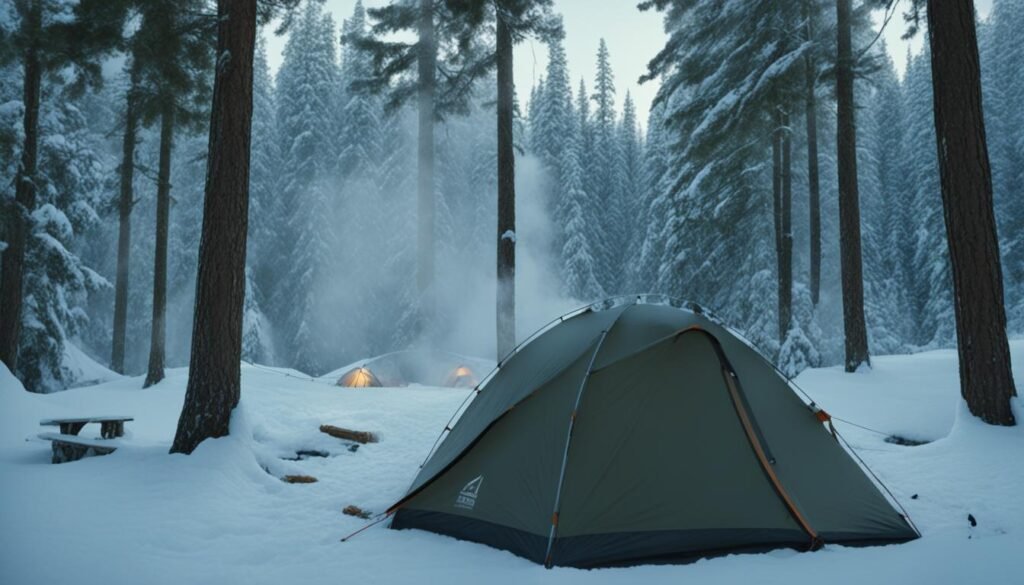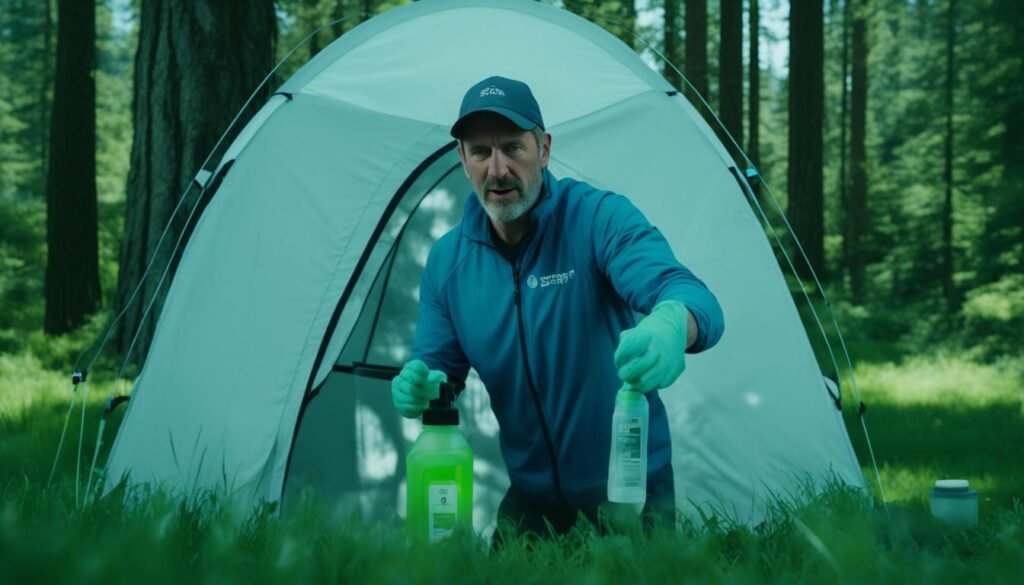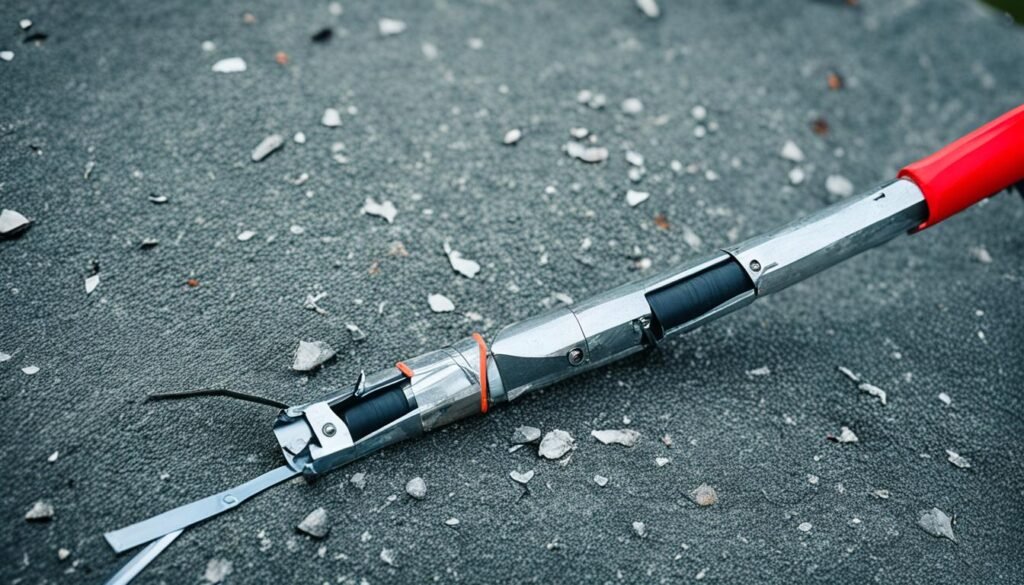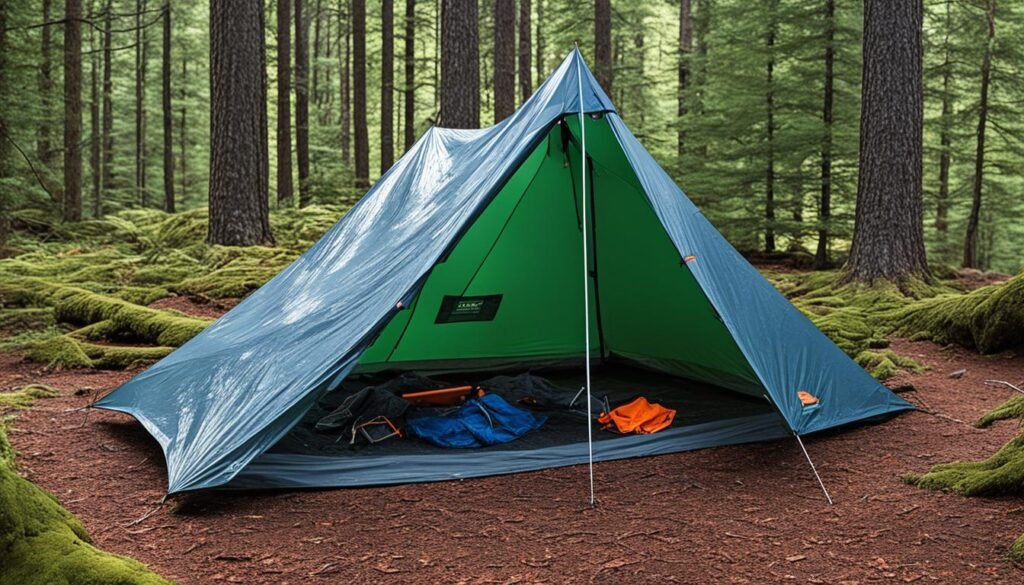Properly drying your tent is essential for maintaining its longevity and preventing the growth of mold and mildew. Whether you’ve just returned from a camping trip or encountered unexpected rain, knowing how to dry your tent effectively can make a significant difference in its lifespan.
Follow these expert tips to ensure that your tent stays clean, dry, and in excellent condition for your next outdoor adventure.
Key Takeaways:
- Select a dry and well-ventilated location for drying your tent.
- Avoid direct sunlight to prevent damage to the fabric.
- Open all windows, doors, and vents for optimal airflow.
- Hang your tent loosely to allow it to air-dry thoroughly.
- Ensure that your tent is completely dry before storing it to prevent mold and mildew growth.
How to Keep Your Tent Dry in the Rain: 6 Tips
When camping in wet conditions, it’s essential to take steps to keep your tent dry and comfortable. Follow these six tips to ensure your tent remains water-free even during heavy rainfall.
- Find the right site away from trees and bodies of water. This will help minimize exposure to falling branches and potential flooding.
- Properly pitch your tent to discourage water pooling. Ensure the rainfly is taut and securely attached to prevent water from accumulating on the tent’s surface.
- Use a groundsheet or footprint underneath your tent to create an additional barrier between the tent floor and the wet ground. This will help prevent moisture from seeping in.
- Invest in a tarp or specialized rainfly to provide extra protection from the rain. Place it over your tent, making sure it is well-secured and extends beyond the edges of the tent to divert rainwater away.
- Line the inside of your tent with plastic, such as a plastic drop cloth or garbage bags, to create a protective barrier against moisture. This will help keep the interior dry even if water manages to seep through the tent fabric.
- Store wet gear in dry plastic bags to prevent water from dripping onto the tent floor. Keeping your gear separate from the tent interior will help maintain cleanliness and dryness inside your tent.
By following these tips, you can ensure your tent stays dry and comfortable even during rainy camping adventures.
How to Keep Moisture Out of Your Tent
It’s important to keep your tent dry and moisture-free to prevent mold growth and maintain its quality. Follow these tent care instructions to keep moisture out and ensure a comfortable camping experience.
Condensation Control
Condensation can lead to moisture buildup inside your tent, which can make it damp and uncomfortable. To minimize condensation, implement the following steps:
- Keep windows and rainfly open for adequate ventilation.
- Set up your tent in a well-ventilated area.
- Use a tent with proper ventilation features, such as mesh windows or vents.
Remove Wet Items
Wet items and food attract moisture and can contribute to excess condensation inside your tent. To keep your tent dry, always remove wet items and store them outside. This will help reduce the overall moisture content within your tent.
Mud Prevention
Mud can bring unwanted moisture into your tent, making it dirty and wet. To keep mud out of your tent, place an additional tarp or mat at the entrance. This will act as a barrier, preventing mud from being tracked inside.
Practice Tent Hygiene
Practicing good tent hygiene can help keep moisture levels down. Here are some tips for maintaining cleanliness and reducing moisture in your tent:
- Remove shoes before entering the tent to keep dirt and moisture outside.
- Store wet items, such as rain gear or towels, outside of the tent.
- Wipe down any surfaces that may have come into contact with moisture.
Keeping moisture out of your tent is crucial for ensuring a comfortable camping experience. By implementing the tips mentioned above, you can maintain a dry and mold-free environment for your next outdoor adventure.
Best Practices for Packing Up Your Tent
Properly packing up your tent is just as important as setting it up. Taking the time to ensure it is clean, dry, and securely stored will help keep it in excellent condition for your next camping adventure. Here are some best practices to follow:
- Never pack away a wet tent: Moisture trapped in your tent can lead to mold and mildew growth, causing damage and unpleasant smells. Be sure to dry your tent thoroughly before packing it up.
- Set it up in a dry location to let it thoroughly dry before storage: Find a sunny spot or a well-ventilated area to set up your tent after use. Allow it to air out and dry completely, both inside and out, before packing it away.
- Sweep out debris and remove pegs and poles: Before folding your tent, remove any dirt, twigs, or leaves that may have accumulated on the floor. Also, detach the tent pegs and disassemble the poles.
- Fold the tent properly to remove air: Start by folding the tent in half lengthwise, then fold it in half again. Next, roll the tent tightly from one end to the other to remove any remaining air. This will help prevent creases and make it easier to fit into its storage bag.
- Roll the tent and store it in its carrying case: Once properly folded, roll the tent tightly and secure it with the attached straps or bungee cords. Place it back into its original carrying case or a dedicated storage bag.
By following these best practices, you can ensure that your tent stays in optimal condition and is ready for your next outdoor adventure.
How to Prevent Mold in Your Tent
Proper maintenance and care are essential for keeping your tent mold-free. Mold can not only ruin the fabric of your tent but also pose health risks to you and your fellow campers. Follow these tips to prevent mold growth and ensure a clean and safe camping experience.
- Choose the right campsite: When setting up your tent, select a campsite that is well-drained and away from low-lying areas prone to moisture buildup. Avoid pitching your tent close to bodies of water or in areas with excessive shade.
- Ensure proper ventilation: Proper airflow is crucial for preventing condensation, which can lead to mold growth. Make use of window openings, mesh windows, and vents to promote air circulation inside your tent. This will help to reduce moisture and keep the interior dry.
- Thoroughly dry your tent: After each camping trip or in the event of rain, make sure to thoroughly dry your tent before storing it. Hang it up or set it up in a well-ventilated area to air out. Pay special attention to the rainfly and the inside of the tent, as these areas are more prone to retaining moisture.
- Clean your tent regularly: Dirt and stains can create a breeding ground for mold. Regularly clean your tent using a mild soap or specifically formulated tent cleaner. Gently scrub the fabric and rinse thoroughly to remove any residue.
- Store your tent properly: When not in use, store your tent in a cool, dry place. Avoid storing it in damp basements or hot attics, as these environments can facilitate mold growth. Consider using a breathable storage bag or container that allows for air circulation. Additionally, using mold-resistant treatments can help prevent mold growth during storage.
Expert Tip:
Before packing away your tent, set it up in your backyard or a well-ventilated area for a few hours to ensure it is completely dry. This extra step can go a long way in preventing mold and extending the lifespan of your tent.
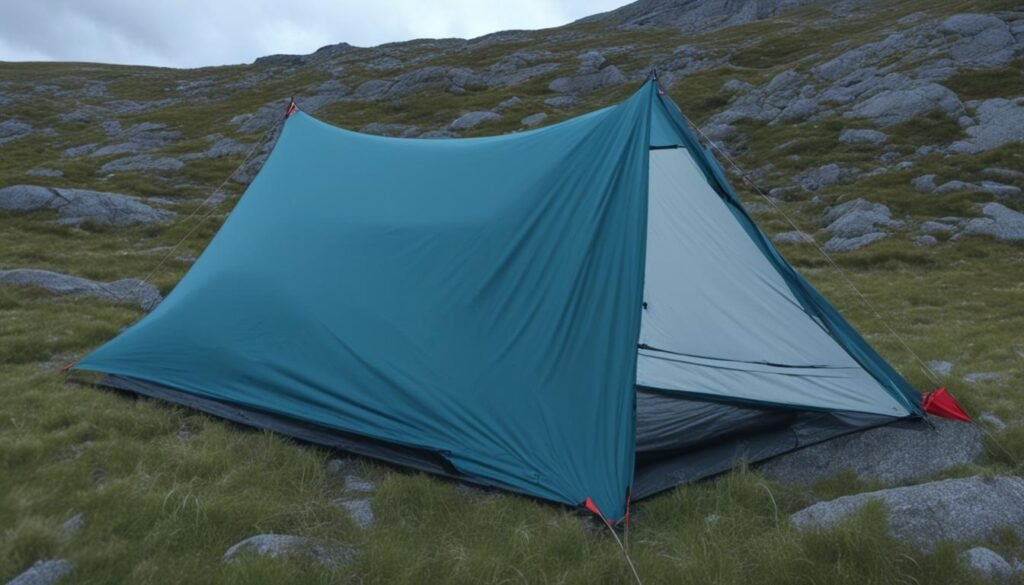
By following these preventive measures, you can significantly reduce the risk of mold growth in your tent. A clean and mold-free tent not only ensures a more enjoyable camping experience but also prolongs the life of your investment. Take the necessary steps to maintain your tent, and you’ll be ready for many memorable camping trips to come.
How to Remove Mold from Your Tent
Mold can be a common issue when it comes to tent care. If you discover mold on your tent, it’s important to address it promptly to prevent further damage and potential health hazards. Here are some steps to effectively remove mold from your tent:
- Set up your tent outdoors on a sunny day. This will help facilitate the drying process and inhibit mold growth.
- Using a soft-bristle brush, gently brush off any visible mold from the tent fabric. Be careful not to damage the tent material.
- Create a solution of water and vinegar or a mild soap. These natural cleaning agents are effective in combating mold and are gentle on the tent fabric.
- Dip a sponge or cloth into the cleaning solution and gently scrub the mold-affected areas. Pay special attention to seams, corners, and any other areas where mold may be present.
- Rinse the tent thoroughly with clean water to remove any remaining cleaning solution.
- Air dry the tent in direct sunlight. Sunlight helps kill mold spores and prevents their regrowth.
Remember, proper ventilation and thorough drying are key elements in preventing mold growth. Take the necessary time and care to ensure your tent is completely dry before packing it away for storage.
Removing mold from your tent not only improves its appearance, but it also protects your investment and promotes a healthier camping experience. By following these steps, you can effectively eliminate mold and maintain a clean and mold-free tent for your future outdoor adventures.
Expert Tip:
Regularly inspect your tent for signs of mold or mildew and address any issues promptly. Prevention is the best approach when it comes to mold, so ensure your tent is stored properly and thoroughly dried after each use.
Effective Tent Care Tips for Overlanders
Mold can be a common issue for overland camping tents due to the varying weather conditions and prolonged use. To keep your tent in optimal condition, follow these effective tent care tips:
- Use dehumidifiers or air conditioners to remove excess moisture from the tent.
- Choose a campsite with good airflow and proper drainage to prevent moisture buildup.
- Properly ventilate your tent by opening windows or using mesh panels for improved airflow.
- Dry your tent thoroughly after each use to prevent mold growth. Hang it out in the sun or use a portable fan to circulate air.
- Clean your tent regularly using mild soap and water. Remove any dirt, debris, or stains that could contribute to mold growth.
- Store your tent properly to prevent mold growth during periods of non-use. Make sure it is completely dry before folding and packing it away.
Follow these tent care instructions and maintenance guide to ensure your overland camping tent stays clean, mold-free, and in excellent condition for your next adventure.
| Tent Care Tips for Overlanders | |
|---|---|
| Tent Care Instruction | Tent Maintenance Guide |
| Use dehumidifiers or air conditioners | Remove excess moisture from the tent |
| Choose a campsite with good airflow | Prevent moisture buildup |
| Properly ventilate your tent | Improve airflow and prevent mold growth |
| Dry your tent thoroughly after each use | Avoid mold growth |
| Clean your tent regularly | Remove dirt, debris, and stains |
| Store your tent properly | Prevent mold growth during non-use |
Essential Tent Care During Setup
Proper care and maintenance of your tent begin even before you start camping. Follow these essential tent care instructions during the setup process to ensure the longevity and functionality of your tent.
1. Choose a Suitable Campsite
When selecting a campsite, look for a smooth and level area to set up your tent. Clear away any debris, including rocks, branches, and sharp objects that may puncture or tear the tent fabric. This will help prevent damage to the tent floor and ensure a comfortable camping experience.
2. Protect the Tent Floor
Using a footprint or groundsheet is an effective way to protect your tent floor from abrasion, moisture, and dirt. Place the footprint underneath your tent to create an additional barrier between the tent and the ground. This will extend the lifespan of your tent and make cleaning and maintenance easier.
3. Avoid Direct Sunlight
While it may be tempting to set up your tent in direct sunlight, prolonged exposure to UV rays can damage the fabric and weaken its waterproofing properties over time. Instead, choose a shaded area or use a tarp or rainfly to provide shade and protect your tent from the harsh sun.
4. Handle Poles with Care
When assembling and disassembling your tent, handle the poles gently to avoid unnecessary stress or damage. Follow the manufacturer’s instructions for proper pole assembly and ensure they are securely inserted into the tent grommets. Mishandling the poles can result in bent or broken sections, compromising the structural integrity of your tent.
5. Ensure Proper Ventilation
Proper ventilation is essential to prevent condensation and maintain a comfortable interior environment. Utilize the mesh windows or vents on your tent to promote airflow and reduce moisture buildup. This will help prevent mold growth and keep your tent fresh and comfortable.
| Tent Care Tips During Setup |
|---|
| Choose a smooth and level campsite |
| Clear away debris |
| Use a footprint to protect the tent floor |
| Avoid setting up in direct sunlight |
| Handle poles gently to avoid damage |
| Use mesh windows or vents for ventilation |
By following these essential tent care instructions during the setup process, you can ensure the durability and longevity of your tent. Taking these preventative measures will help you enjoy many memorable camping adventures without worrying about unnecessary damage or maintenance issues.
Tent Care During Use
When using your tent, it’s important to follow proper care instructions to maintain its condition and prevent any potential issues. Here are some essential tips to keep in mind:
- Be gentle with zippers to avoid damage: Zippers are susceptible to damage, especially when pulled or forced. Take care when opening and closing zippers to ensure they function properly and avoid any tears or breakages.
- Keep boots and fragrant items outside the tent or in the vestibule: To minimize dirt and unwanted odors inside your tent, it’s best to remove boots and store them in the vestibule or outside the tent. Similarly, keep any fragrant items outside to prevent attracting animals or insects.
- Do not leave an unsupervised dog inside the tent: While your furry friend may want to join you inside the tent, it’s important not to leave them unsupervised. Dogs may scratch or chew on the tent, causing damage. Ensure your dog is properly supervised or consider setting up a separate designated area for them.
- Regularly inspect the tent for signs of mold or moisture buildup: While using your tent, take the time to inspect it for any signs of mold, mildew, or moisture buildup. Pay close attention to corners, seams, and areas prone to condensation. Early detection can help prevent further damage or health issues.
- Clean the tent after each trip to prevent mold growth: After each camping trip, it’s important to clean your tent thoroughly. Remove any debris, dirt, or stains that may have accumulated. This will help prevent mold growth and maintain the overall cleanliness and longevity of your tent.
By following these tent care instructions during use, you can ensure that your tent remains in top condition and provides a comfortable shelter during your outdoor adventures.
Proper Tent Care During Break Down
When it’s time to pack up your tent after a camping trip, it’s important to follow proper care instructions to ensure its longevity. Here are some essential tent care tips to consider during the break down process:
- Shake out dirt and debris: Before packing up your tent, give it a good shake to remove any dirt, leaves, or other debris that may have accumulated during your camping trip.
- Remove poles gently: When disassembling your tent, avoid pulling on the poles. Instead, push them out from the inside to release tension on the elastic cord and prevent unnecessary stress.
- Fold poles starting in the middle: To evenly distribute tension and avoid kinks, start folding the poles in the middle and work your way towards the ends.
- Dry the tent: Before packing your tent, try to dry it as much as possible. Spread it out in the sun or use a towel to absorb any remaining moisture. This helps prevent mold and mildew growth while in storage.
- Store the tent loosely: Finally, store your tent in a cool, dry place. Avoid compressing it too tightly, as this can damage the fabric. Loosely packed tents allow for proper ventilation and help maintain their shape over time.
Following these tent care instructions during the break down process will help keep your tent in excellent condition for future camping adventures.
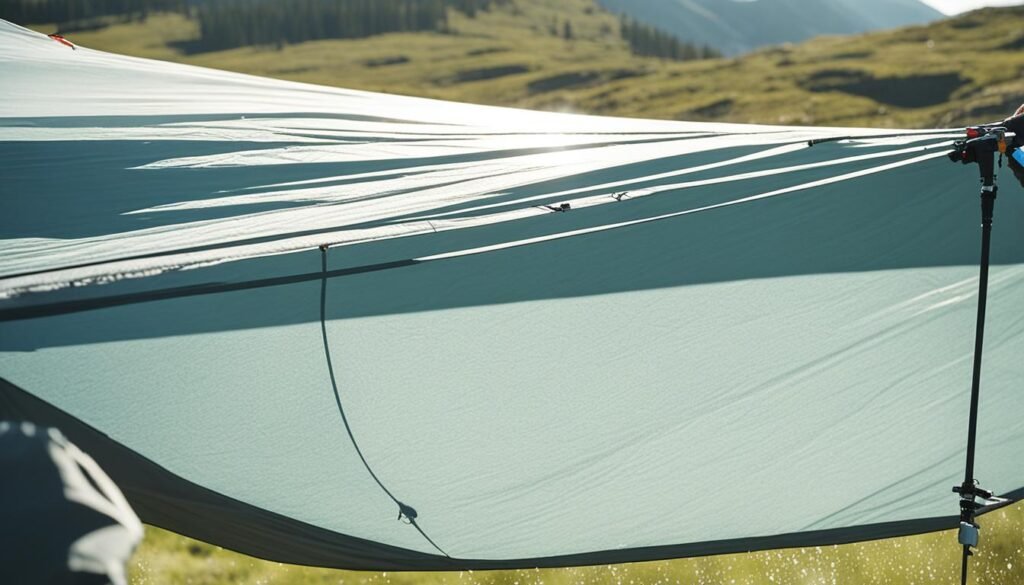
Note: The image above is for illustrative purposes only and does not represent the exact tent care instructions mentioned.
Tent Care at Home
Proper tent care extends beyond your camping trips. Taking care of your tent at home ensures its longevity and performance during future adventures. Follow these essential tent care instructions to maintain your tent in optimum condition:
Air-Dry Your Tent
After each use or cleaning, it’s crucial to thoroughly air-dry your tent. Moisture left in the fabric can lead to mold and mildew growth over time. Hang your tent outside or set it up in a well-ventilated area, ensuring all areas are exposed to air circulation. Allow it to dry completely before storing it to prevent any damage or musty odors.
Ensure Complete Dryness
Before storing your tent, ensure that it is completely dry. Even a trace of moisture can attract mold and compromise the integrity of the fabric. Check all seams, corners, and folds for any signs of dampness before proceeding with storage. Patience is key to prevent potential damage and costly repairs in the future.
Use a Breathable Storage Bag
For long-term storage, invest in a breathable bag or a mesh container to store your tent. These specialized storage options allow air circulation, preventing moisture buildup and mildew growth. Avoid using plastic bags or airtight containers as they trap moisture and promote the growth of mold and mildew.
Avoid Damp or Hot Storage Locations
When choosing a storage location for your tent, avoid areas that are damp or prone to excessive heat. Dampness can lead to mold growth, while high temperatures can damage the fabric and coatings. Look for a cool, dry, and well-ventilated space to preserve the quality of your tent.
Thoroughly Clean and Address Issues
Prior to storing your tent, perform a thorough cleaning to remove any dirt, stains, or debris. Follow the manufacturer’s instructions for cleaning your specific tent model. Address any issues promptly, such as repairing small tears or replacing worn-out components. Taking care of your tent before storage ensures that it’s in top shape for your next adventure.
In summary, tent care at home is crucial for maintaining the longevity and performance of your tent. Thoroughly air-drying, ensuring complete dryness, using a breathable storage bag, avoiding damp or hot storage locations, and performing a thorough clean before storage are all essential tent care practices. By following these tent care instructions, you can enjoy many more memorable camping trips with a well-maintained and reliable tent.
How to Clean Your Tent
Properly cleaning your tent is an essential part of its maintenance and care. By following these instructions, you can effectively remove dirt, stains, and mold, ensuring your tent remains in excellent condition for future camping trips.
Cleaning Guidelines
When it comes to cleaning your tent, there are a few important guidelines to remember:
- Avoid machine-washing or machine-drying your tent: Machine-washing or machine-drying can damage the fabric and coatings of your tent. It is best to clean your tent by hand.
- Clean by hand using a non-abrasive sponge and mild soap: Fill a bucket with water and add a small amount of mild soap. Use a non-abrasive sponge or cloth to gently clean the tent fabric.
- Avoid using household cleaners that can damage the tent fabric or coatings: Some household cleaners contain harsh chemicals that can deteriorate the fabric or coatings of your tent. Stick to mild soap or tent-specific cleaning products.
- Rinse thoroughly and air-dry the tent before packing it away: After cleaning, thoroughly rinse the tent to remove any soap residue. Hang it or lay it flat in a well-ventilated area to air-dry completely. Make sure the tent is completely dry before packing it away to prevent mold growth.
- Address stains or mold promptly with the appropriate cleaning solution: If you notice stains or mold on your tent, it is important to address them promptly to prevent further damage. Consult the tent manufacturer’s guidelines or use a specialized cleaning solution to treat stains or mold.
Example Quote:
“Taking the time to properly clean your tent after each use ensures that it remains in good condition and ready for your next adventure. Avoiding harsh cleaners and gently hand-cleaning with mild soap will help extend the lifespan of your tent and keep it looking its best.” – Outdoor Gear Experts
Remember, keeping your tent clean not only enhances its longevity but also contributes to a more enjoyable camping experience. Regular cleaning and careful maintenance will help you get the most out of your investment in outdoor gear.
| Cleaning Guidelines | Tent Care Tips |
|---|---|
| Avoid machine-washing or machine-drying | Dry your tent thoroughly before storage |
| Clean by hand using a non-abrasive sponge and mild soap | Store your tent in a cool, dry place |
| Avoid using harsh household cleaners | Regularly inspect for signs of mold or moisture buildup |
| Rinse thoroughly and air-dry the tent | Address stains and mold promptly |
By following these tent care instructions and regularly cleaning your tent, you can ensure that it stays in excellent condition and ready for your next camping adventure.
Waterproofing Tent Seams and Coatings
Ensuring your tent is properly waterproofed is essential for keeping you dry during your camping adventures. Here are some steps you can take to waterproof the seams and coatings of your tent:
- Reseal leaky seams with seam sealer: Over time, the seams of your tent may start to leak. To fix this issue, apply a seam sealer to the inside of the tent seams. This will create a waterproof barrier and prevent water from seeping through.
- Use tent-specific products to reapply waterproof coatings: Many tents come with a waterproof coating on the fabric. However, this coating can wear off over time. To maintain your tent’s waterproof capabilities, use tent-specific products, such as waterproof sprays or coatings, to reapply a fresh layer of protection.
- Follow manufacturer’s instructions and allow for proper drying time: When applying seam sealer or waterproof coatings, it’s important to carefully read and follow the manufacturer’s instructions. Allow the product to dry completely before using or storing the tent.
- Check for signs of coating failure and consider replacing the tent if necessary: Inspect your tent regularly for any signs of coating failure, such as peeling or flaking. If the coatings are significantly damaged or deteriorated, it may be time to replace your tent to ensure optimal waterproofing.
- Use the correct product for your tent’s fabric and coatings: Different tent fabrics and coatings require specific waterproofing products. Make sure to use the correct product that is recommended for your tent’s materials to achieve the best results.
By taking the necessary steps to waterproof your tent seams and coatings, you can ensure that you stay dry and comfortable on your outdoor adventures, no matter the weather conditions.
Tips for Repairing and Extending the Life of Your Tent
Proper tent care and maintenance are crucial for ensuring the longevity and performance of your outdoor shelter. In this section, we will explore some essential tips and techniques to repair small tears, zipper issues, and pole damage, ultimately extending the life of your tent. By being proactive and following these tent care instructions, you can enjoy many more camping adventures with a reliable and durable shelter.
Inspect and Address Issues Promptly
Regular inspections are essential to identify and address any issues with your tent. Look for small tears in the fabric, malfunctioning zippers, or damaged poles. By catching these problems early on, you can prevent them from worsening and causing more significant damage to your tent.
Repairing Small Tears
Small tears in your tent fabric can occur from rough handling or natural wear and tear. Repair them promptly using a tent repair kit or a patch specifically designed for your tent material. Follow the manufacturer’s instructions for application and ensure a secure and watertight repair.
Addressing Zipper Issues
Zipper malfunctions can occur due to dirt, debris, or misalignment. Clean the zipper with a soft brush or cloth and apply a lubricant designed for zippers to ensure smooth operation. If the zipper is damaged beyond repair, consider replacing it with a new one to keep your tent fully functional.
Fixing Pole Damage
When dealing with pole damage, assess the severity of the issue. Minor damage, such as bent sections, can often be repaired using splints or pole sleeves. Replace any broken or severely damaged pole sections with compatible replacements. Properly maintaining and storing your tent poles will help prevent damage in the first place.
Reinforce High-Stress Areas
High-stress areas of your tent, such as corners and pole attachment points, are prone to wear and tear. Consider reinforcing these areas with additional fabric or tent repair patches. Reinforcing these spots will help distribute the tension and extend the lifespan of your tent.
Follow Proper Tent Care Protocols
Extend the life of your tent by following proper care protocols. Always set up and pack away your tent according to the manufacturer’s instructions. Avoid exposing your tent to unnecessary stressors, such as harsh UV rays or extreme weather conditions, whenever possible. Additionally, take precautions to prevent damage from wildlife or sharp objects around your campsite.
Consider Tent Replacement if Necessary
If your tent becomes heavily damaged or shows signs of significant wear that cannot be repaired effectively, it may be time to consider replacing it. Investing in a new tent will ensure reliable protection and comfort during your camping trips.
By implementing these tent care instructions, you can effectively repair and extend the life of your tent, saving you money in the long run and providing peace of mind during your outdoor adventures.
| Repair Technique | Description |
|---|---|
| Small Tear Repair | Patch small tears using a tent repair kit or material-specific patch. |
| Zipper Lubrication | Clean zippers and use a zipper lubricant to keep them functioning smoothly. |
| Pole Damage | Repair bent sections with splints or pole sleeves; replace severely damaged or broken sections. |
| Reinforce High-Stress Areas | Add fabric or repair patches to high-stress areas for added durability. |
| Tent Care Protocols | Follow manufacturer’s instructions for proper setup, takedown, and storage. |
| Tent Replacement | If heavily damaged or significantly worn, consider replacing the tent for optimal performance. |
Conclusion
Taking proper care of your tent is essential for preventing mold growth, extending its lifespan, and ensuring a comfortable camping experience. By following the tent care instructions and maintenance guide outlined in this article, you can keep your tent clean, dry, and in great condition for many outdoor adventures to come. Remember to always thoroughly dry your tent before packing it away and address any issues promptly to avoid further damage.
Properly drying your tent after each use is crucial to prevent mold growth. Avoid packing away a wet tent as it can lead to unpleasant odors and damage to the fabric. Instead, set up your tent in a dry location and allow it to air dry completely before folding and storing it. It’s also important to regularly inspect your tent for signs of mold or moisture buildup and take prompt action to clean and address the issue.
By practicing good tent care habits, such as keeping your tent dry in the rain, preventing moisture buildup inside, and properly packing up your tent, you can enhance its longevity and maintain its performance. Remember to choose a suitable campsite, provide proper ventilation, and clean your tent regularly. Storing your tent in a cool, dry place and using mold-resistant treatments can also help prevent mold growth and prolong its life.
So, whether you’re an avid camper or a seasonal adventurer, remember to take care of your tent – it’s your home away from home in the great outdoors. Follow these tent care instructions and maintenance tips, and you’ll be well-equipped to enjoy many memorable camping trips with a clean, dry, and well-maintained tent. Happy camping!
FAQ
How should I dry my tent after use?
To properly dry your tent, set it up in a dry location and let it air dry completely before storage.
What can I do to keep my tent dry during rainy weather?
To keep your tent dry in the rain, pitch it properly, use a groundsheet or footprint, and use a tarp or rainfly to provide extra protection.
How can I prevent moisture from building up inside my tent?
To prevent moisture buildup inside your tent, ensure proper ventilation by keeping windows and rainfly open and removing wet items and food.
How should I pack up my tent after it gets wet?
After a wet camping trip, make sure to thoroughly dry your tent before packing it away. Sweep out debris, remove pegs and poles, and fold the tent properly to remove air before rolling and storing it.
How can I prevent mold growth in my tent?
To prevent mold growth in your tent, thoroughly dry it after each use, clean it regularly, and store it in a cool, dry place. You can also use mold-resistant treatments.
What should I do if I find mold in my tent?
If you find mold in your tent, brush off visible mold, use a solution of water and vinegar or mild soap to clean affected areas, rinse thoroughly, and air dry the tent in direct sunlight before packing it away.
What tent care tips are important for overland camping?
For overland camping, use dehumidifiers or air conditioners to remove excess moisture, choose campsites with good airflow and drainage, and properly ventilate and dry your tent after each use.
What tent care is essential during setup?
During setup, choose a smooth, level campsite, use a footprint for floor protection, avoid setting up in direct sunlight for extended periods, handle poles gently, and use mesh windows or vents for proper ventilation.
How can I take care of my tent while using it?
While using your tent, take off shoes and store wet items outside, avoid leaving unsupervised dogs inside, inspect the tent regularly for signs of mold or moisture, and clean it after each trip to prevent mold growth.
What should I consider when packing up my tent?
When packing up your tent, shake out dirt and debris, remove poles by pushing instead of pulling, fold the poles starting from the middle, dry the tent as much as possible, and store it loosely in a cool, dry place.
How should I care for my tent at home?
To care for your tent at home, make sure it is completely dry before storing it, use a breathable bag or mesh container for long-term storage, and avoid storing it in damp or hot locations.
What is the proper way to clean my tent?
To clean your tent, avoid machine-washing or machine-drying it. Instead, clean it by hand using a non-abrasive sponge and mild soap. Rinse thoroughly and air dry before packing it away.
How can I waterproof my tent seams and coatings?
To waterproof your tent seams and coatings, use tent-specific products to reapply waterproof coatings. Follow the manufacturer’s instructions and allow for proper drying time.
Are there any tips for repairing and extending the life of my tent?
Yes, you can repair small tears, zipper issues, and pole damage. Consider adding reinforcements to high-stress areas for added durability. Following proper tent care protocols will also help extend its lifespan.


